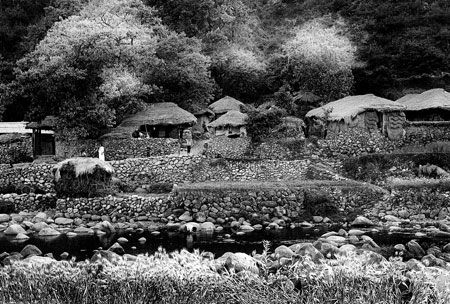Rare photos of past Korean society to be shown in Japan

“Friends” by Japanese photographer Takumi Fujimoto taken in 1970s-’80s in Korea are to be seen at the Korea Cultural Center in Tokyo from Jan. 16 to 31. / Courtesy of National Folk Museum of Korea
Two old men, dressed in traditional Korean garb, face the camera, one performing what seems like a traditional dance move, are seen against the sea off Jindo, South Jeolla Province.
Japanese photographer Takumi Fujimoto captured during the 1970s and ’80s what he saw as exotic and rare scenes that revealed humanity. Fujimoto first came to Korea in August 1970 when diplomatic and cultural exchanges between Japan and Korea were rare, and Korea was undergoing a drastic social transformation. He was mesmerized by the strange country, and since then he has visited Korea over 50 times to depict the ordinary lives of Koreans with his affectionate eyes.
He donated 46,377 photos carrying images of Korean society to the National Folk Museum of Korea in 2011. The museum held an exhibition titled “Daily Lives of Our Recent Past, 1970s-1980s” in August to celebrate his donation.
Now his photos will go on show in Japan to bridge the cultural gap between the two countries. Some 60 of his photos will be at the gallery of the Korea Cultural Center in Tokyo from Jan. 16 to 31.
His photography shows how Korea has changed rapidly from an agrarian society to an industrial one through dynamic images. The collection portrays scenes of daily Korean life such as women selling in traditional markets arguing with those trying to steal their customers.
Thatched houses in Dongcheon Village in South Gyeongsang Province and women selling fish in Busan in the 1970s and a carnival show on a bus roof during the Gangneung Dano Festival in 1986 and other various rural and urban images and agricultural and port cities are captured in Fujimoto’s photos. His shots have historical significance as such images cannot be seen anymore as most of them have already disappeared.
Fujimoto’s affection toward Korea was inspired by his father who admired Yanagi Muneyoshi (1889-1961), known for his deep affection for Korean ceramics and folk arts. His father was influenced by books written by Muneyoshi about Korean crafts.
Since he first came here, the photographer has explored diverse regions such as Yeongju, Andong, Gimcheon and Hapcheon to portray folk arts and artisans that continue past traditions.
The exhibition in Japan will feature photos of folk arts in Seoul’s Insa-dong, the southwestern Jeolla Province and the southeastern Gyeongsang Province in the first section while the landscapes of Korea showing traditional homes, folk beliefs and festivals are in the second. The third part will display photos that reveal the energy and spirit of Koreans.
“In the 1970s and ’80s, the two countries didn’t know each other very well due to deep-rooted historical and political conflicts although they are geographically close. This exhibition will offer an opportunity for the Japanese audience who are accustomed to only modern Korean society to help them better understand Korean history and culture through sharing the photos,” the museum said in a statement.
After the exhibition in Tokyo, it will go to Osaka’s Korea Cultural Center from Feb. 2. Apart from the exhibition, the Korea Cultural Center in Tokyo will present a lecture on “Revisiting Korea: the Streets Where Yanagi Muneyoshi, Kawai Kanjiro, Shoji Hamada Walked Through” on Jan. 26. <The Korea Times/Chung Ah-young>





























































